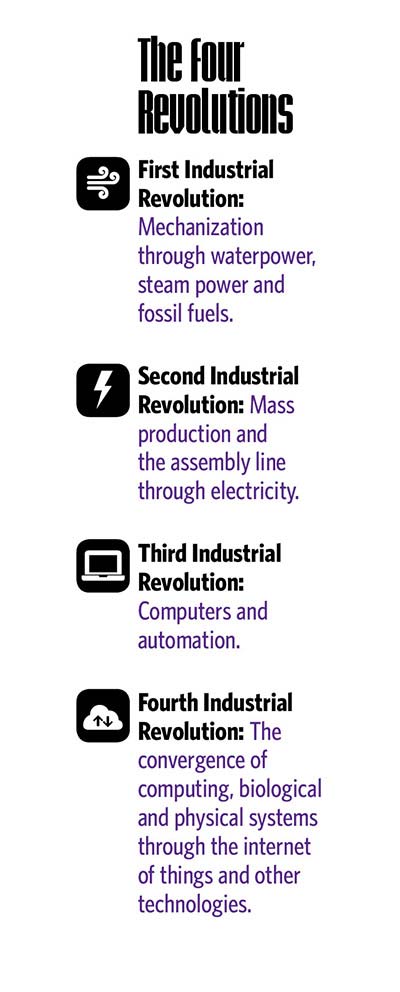Leading the Revolution
The signs of revolution are all around us.
“We are witnessing extraordinary advances and phenomenal breakthroughs on almost a daily basis. It’s something that no businessperson can ignore.” —Ravi Venkatesan, chairman, Bank of Baroda and co-chairman, Infosys Ltd., Bengaluru, Karnataka, India
In London, Google’s artificial intelligence (AI) research subsidiary DeepMind announced a partnership with the U.K.’s National Health Service (NHS) and Moorfields Eye Hospital to develop an AI system to spot sight-threatening conditions in digital scans of the eye.
Meanwhile, U.S. lawmakers in June introduced the first federal legislation to regulate self-driving cars. The legislation would allow manufacturers to test autonomous vehicles before they’ve met all the necessary safety standards, which the bill aims to establish for driverless vehicles.
And in Kampen, Netherlands, technology group Wärtsilä and logistics company DHL have successfully completed a pilot program to test the use of autonomous mobile robots in a warehouse environment to learn about the human-technology interface between robots and employees.
Welcome to the Fourth Industrial Revolution, where digital technologies are advancing at a furious rate, merging the physical, digital and biological worlds. The internet of things (IoT), mobile supercomputing, autonomous vehicles, robots and drones, 3-D printers, deep learning neural networks and nanotechnology are just some of the technologies beginning to overlap and coalesce.
For business leaders, the stakes are enormous: Job displacement, the complete restructuring of global economies and emerging safety and security risks are just a few of the elements that organizations will face. “We are witnessing extraordinary advances and phenomenal breakthroughs on almost a daily basis,” says Ravi Venkatesan, chairman, Bank of Baroda and co-chairman, Infosys Ltd., Bengaluru, Karnataka, India. “It’s something that no businessperson can ignore.”“We are redefining and reshaping almost every aspect of human life,” says Murat Sönmez, head of the World Economic Forum (WEF)’s Center for the Fourth Industrial Revolution in San Francisco. “This seismic shift represents a huge opportunity to address some of the global challenges for humanity. But it also represents risks because of the speed and scale at which it is evolving.”
Navigating this brave new world is not for the weak of mind. The Fourth Industrial Revolution “is not a futuristic concept, it’s happening now,” says Mr. Sönmez, a member of WEF’s managing board. “Disruption was an enormous factor in previous industrial revolutions. But the speed, scale and scope of change now taking place far exceed anything in the past. Organizations must approach today’s business environment completely differently.”
“The Fourth Industrial Revolution is all about new technologies and new capabilities opening up new vistas. We will solve problems we never dreamed of, but create new problems. There will be a huge shift in how we approach computing, business and life.” —Bryan Catanzaro, vice president of applied deep learning research, Nvidia, San Francisco
The Right Stuff

Bosch Sensortec GmbH is a company that should have no problem riding this wave of disruption. After all, as a leading developer of micro-electro-mechanical systems (MEMS) sensors, its products are used in many of today’s most ubiquitous and most anticipated technologies—including smartphones, tablets, wearable devices, drones, augmented reality (AR) devices, virtual reality (VR) devices and IoT applications. Nonetheless, Stefan Finkbeiner, CEO of the Reutlingen, Germany-based organization, spends a lot of time thinking about what shifts the revolution might beget.
For Bosch Sensortec, the key to future-proofing the organization is focusing on growth. In fact, according to Gartner’s 2017 CEO Survey, growth is the top business priority for CEOs in 2017 and 2018. But Mr. Finkbeiner stresses that his company cannot pursue growth for growth’s sake—it has to be the right kind.According to Mr. Finkbeiner, the rapid pace of change means he and other executives must constantly be looking for where the new market opportunities are and then adapt to those opportunities. “It’s about having the customer solutions,” he says. “That means having the right technology with the right solutions at the right time. That’s a totally different kind of thinking.”
Take one of Bosch Sensortec’s latest products, the BML050. It is a high-precision optical MEMS scanner for interactive laser projection applications, which the company launched in February at the Mobile World Congress 2017. The MEMS scanner—which can be used in everything from VR heads-up displays to wearables to smart home appliances—transforms any surface into a virtual user interface. The BML050 broadens Bosch Sensortec’s product offerings, extending them into optical solutions. Crucially, the product delivers on the organization’s goal of developing human-centric technologies. “It’s not just about how devices communicate or sense their surrounding environments, but increasingly about how technology interacts with human beings,” says Mr. Finkbeiner. “The virtual user interface solution gives any kind of device a unique personality of its own, enabling technology to interact with people in an intuitive manner, to make life simpler and more exciting.”
No Company Is an Island
The need for organizations to embrace new R&D models that boost innovation is increasing. Partnerships with other companies—even competitors—as well as accelerators, incubators and venture capital firms are becoming the coin of the realm. They expose an organization and its leadership to outside thinking and help it build a broader and deeper ecosystem of ideas, products and services.
“A company has to learn that in the world of IoT, you can’t do everything on your own,” says Mr. Finkbeiner.
He has pushed his company to explore partnerships that can add to or supplement their competencies. For example, Bosch Sensortec partnered with an organization to integrate microcontrollers—a small computer on a single integrated circuit—into the sensors they develop for various products such as smartphones. As Mr. Finkbeiner explains, “we’re not a microcontroller company,” but it is an in-demand piece of technology that could work to improve and expand his organization’s offerings.
Getting everyone on board with forming these alignments, however, has required pushing a mindset change through the organization. “Engineers are very keen on doing things on their own,” he says. At the same time, Bosch Sensortec is typically the company others turn to to bolster their products, not the other way around. For example, telecommunications giant Qualcomm recently announced a partnership with Bosch Sensortec to integrate Bosch’s BMX055 absolute orientation sensor into its VR headsets.
The key to making cross-company collaboration part of organizational culture, Mr. Finkbeiner says, is showing the unique strategic value of partnerships. “You have to define what you want to address,” he says. “Then communicate the strategy. Explain it to the workforce several times. Implement the strategy. Show successes along the way. And celebrate the small steps.”
Risk vs. Reward
The full potential of the Fourth Industrial Revolution lies in the future. While many predict the technologies to come could help developing nations advance more quickly or improve the quality of life for underserved populations, many experts sound notes of caution about the unknown threats to social, economic and political systems.
Not only will large and established companies be swept away, the nature of business and life will change dramatically,” Mr. Venkatesan says. At the very least, the nature of jobs and work will change as automation, robots and AI supplant people in many fields. According to the WEF, by 2020 more than 5 million jobs could be lost in a disruptive labor market Share on X spurred by the Fourth Industrial Revolution.
Another risk? Mr. Venkatesan argues that in many cases, regulators lag behind innovators when it comes to the emerging technologies promised by the Fourth Industrial Revolution, which he says can be a pro and a con. Being overzealous in regulating these technologies, he says, risks innovation inertia.
But with those possibilities come thorny questions, Mr. Venkatesan says. “In a country like India with a huge labor surplus and employment challenges, is it OK for companies to automate everything or should some boundaries exist? In an age of smart machines, do businesses have a social responsibility when it comes to employment? In a country where literacy levels are still relatively low, gullibility is high, fraud is rampant and justice is slow, what guardrails are needed to protect people as the country goes digital? At some point, we will have to ask the question: Just because we can do something with technology, should we do it?”
Ultimately, there will be winners and losers, huge gains and enormous setbacks. Business leaders, policymakers and scientists must evolve beyond legacy models. They must rethink the nature of competition, global trade, economic policies and the role of technology. “The Fourth Industrial Revolution is all about new technologies and new capabilities opening up new vistas. We will solve problems we never dreamed of, but create new problems,” says Bryan Catanzaro, vice president of applied deep learning research at semiconductor firm Nvidia in San Francisco. “There will be a huge shift in how we approach computing, business and life.”
Deep Transformation
While the previous three industrial revolutions—which span more than two centuries—largely revolved around mechanization, the Fourth Industrial Revolution is something else entirely. It is blending the physical, digital and biological realms.
Not surprisingly, much of this new revolution is being driven by artificial intelligence (AI), deep learning and machine learning. Developments in these fields over the past few decades have led to an astounding array of capabilities. Increasingly, computers powered by neural networks that sift through data in a similar way to the human brain outperform humans and handle tasks that humans cannot. What is more, machines are now able to learn on their own and train themselves to perform better over time.
Thomas Dietterich, professor emeritus for the School of Electrical Engineering and Computer Science at Oregon State University, says AI will help build more efficient supply chains, a better logistics framework and smarter factories. As the data stream turns into a data deluge, AI will make the signal-to-noise ratio more manageable.
At the same time, augmented reality (AR) and virtual reality (VR) are seeping into the workplace. “Using immersive technology, it’s possible to assemble people from all over the world to collaborate and interact in a virtual environment,” says Bryan Catanzaro, vice president of applied deep learning research, Nvidia.
Yet AI and digital technology are only part of the unfolding story. The Fourth Industrial Revolution is also unlocking the secrets of genes and the human brain. Today, researchers are developing microchips that, when implanted in the brain, help a disabled person or stroke patient regain lost functionality. They are developing prosthetics that can create a bionic body. In addition, synthetic biology and chemistry are taking shape. For example, researchers now use a gene-editing tool called CRISPR to adapt genes for specific purposes—such as creating crops that are disease- or insect-resistant and engineering new types of medicine or artificially produced organs.
The results will be nothing less than transformative. “In the past, most technology advances have resulted in physical gains,” says Mr. Catanzaro. “It’s been about new ways to build things or do things. The difference with the Fourth Industrial Revolution is that it’s augmenting our intelligence and, in many cases, introducing intelligence that surpasses humans.”



